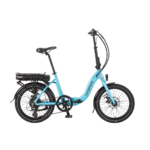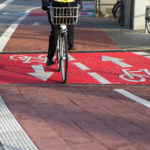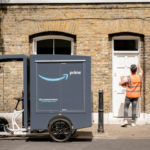As I approach another birthday which is a milestone,its time to start planning my long dreamed of holiday.Before I cant do it any more,we're going to hire a motor home and " bugger off " for a month.Get the ferry to Calais and see what we can get up to within four weeks.I want to take a couple of folding ebikes.My missus fancies a bit of Switzerland en route.I wondered if there are any of those Panasonic hub type bikes folders.Im going to need all the help I can get if we make it there!
Folding ebike with central motor
- Thread starter Bigbee
- Start date
Hire one in Belgium its probably cheaper........And a better route to Switzerland avoiding expensive French toll roads.
My favourite route to Italy is via:
Calais/Belgium/Luxembourg/Metz/Strasbourg/Colmar/Basle/Gottard tunnel/Milan.....
Cheaper fuel in Luxembourg, no tolls, and the municipal site at "Obernai" is a popular stop on this route.
My favourite route to Italy is via:
Calais/Belgium/Luxembourg/Metz/Strasbourg/Colmar/Basle/Gottard tunnel/Milan.....
Cheaper fuel in Luxembourg, no tolls, and the municipal site at "Obernai" is a popular stop on this route.
Apart from Panasonic's own one, now only available in Japan, there's only the BikeTech Flyer Faltrad which you can see open and folded on this agent's webpage
Vita Electric
It's very light and is beautifully made with a choice of gear systems, but it is very expensive. These are the last UK prices I saw:
Folding
Faltrad NS 20kg, Shimano 8 gear Nexus standard, Shimano roller pulse braking (anti-skid) BM-IM70 V-Brake, . . . . . . . . . . £2,100
Faltrad KS 19kg, Shimano 9 gear Capreo . . . £2,100
As they are made in Switzerland, you may be able to hire them there to at least try them for a while without bankrupting yourself.
.
Vita Electric
It's very light and is beautifully made with a choice of gear systems, but it is very expensive. These are the last UK prices I saw:
Folding
Faltrad NS 20kg, Shimano 8 gear Nexus standard, Shimano roller pulse braking (anti-skid) BM-IM70 V-Brake, . . . . . . . . . . £2,100
Faltrad KS 19kg, Shimano 9 gear Capreo . . . £2,100
As they are made in Switzerland, you may be able to hire them there to at least try them for a while without bankrupting yourself.
.
Last edited:
Yamaha have just introduced a Panasonic unit copy, but no-one puts it into a folder. There's room for another manufacturer to make a Panasonic based folder at a more realistic price, but it's likely it would still be well over £1000.Its not just Switzerland we're aim to hit,so I wanted to take them with us.No other motor apart from Panasonic?They seem to have it sewn up
.
Yes, the BH E-motion City 650 is the cheapest well equipped one, but it only has the 8 Ah hour battery, £65 extra for the 10 Ah one. The similar Monark is the same price but only has a three speed gear hub so is not quite so suitable for hills, but it includes the 10 Ah battery.Ok,maybe I should look at full size bikes with central motor?Ithink e-motion is the cheapest at around £1350?Still a ot of dosh.
An alternative is to mount a Cyclone chain drive motor on a suitable cheap Chinese folder. Cyclone make their own folders and would probably ship one for you, or you could use theior kit on a bike you buy. Not as sophisticated or well made as the Panasonic, but potentially much cheaper.
Cyclone Taiwan
.
Last edited:
No reason why a crank motor can't have a throttle. In the case of the panasonic system however, the only throttle available is a walk-along thumb throttle which is limited to around 4mph. I have seen crank motor kits which have throttle control though.
Yes, the BH E-motion City 650 is the cheapest well equipped one, but it only has the 8 Ah hour battery, £65 extra for the 10 Ah one. The similar Monark is the same price but only has a three speed gear hub so is not quite so suitable for hills, but it includes the 10 Ah battery.
An alternative is to mount a Cyclone chain drive motor on a suitable cheap Chinese folder. Cyclone make their own folders and would probably ship one for you, or you could use theior kit on a bike you buy. Not as sophisticated or well made as the Panasonic, but potentially much cheaper.
Cyclone Taiwan
.
Did I read some where that you said derailler ( sp?) were better with the Panasonics for hills?Is the Monarks weakness with a three speed hub because its a hub or lack of gears?
thanks!
Yes, the Cyclone ones are all throttle controlled, and their pedelec add-on is an optional extra. Personally I wouldn't bother with it as it's a bit crude and won't be much good, nothing like the Panasonic unit's sophistication. I'd just use the supplied throttle.Can a central crank motor have a throttle?I cant see them on the Pansaonic powered bikes
.
Derailleur or Hub
Hi Guys
I am Andrew from Onbike. We sell both E-Motion and Monark bikes.
I thought I would add some thoughts on the Derailleur vs hub debate. I should point out that we sell both systems, both have their place.
Firstly the advantage of a hub is that you can change gear when you are not peddling. This is great if you have to stop at lots of traffic lights or junctions unexpectedly. The other advantages are lower maintinence and a "thicker chain". Hubs come in many different ratio ranges. The Monark hub has a range of 186%. If first gear is too hard for you it is easy to alter the ratios by changing the rear cog but this will also effect the other gears.
The disadvantages of a hub are efficency. It is very hard to obtain exact figures for the efficency of hub gears most figures sugest 6-10%, worst case, loss compared to derailleur. On the Panasonic system both the motor and you legs are driving through the gears. If we take an example of your legs giving 200W and the motor giving 200w the loss could be 8% of 400w giving 32W loss or more! Hubs tend to be least efficent in 1st gear. most hubs are very efficient in the mid gears ( 2nd on the Monark ) 4th on Nexus 8 speed. With a hub as the ratio get further from 1:1 the efficency drops. So although a 3 speed has a lower ratio than a 7 speed it is more efficient.
The other big disvantage of the hub is that you have to stop pedling to change down for a hill. The Panasonic system keeps driving the chain after you stop pedling so you have to pause for longer than normal. This can be annoying when going up a hill which is when you want to be giving more power rather than pausing.
The advantage of derailleur gears are efficieny as discussed above. You can also choose your ratios. The E-Motion is fitted with a 13 to 26 Cassette as standard giving a 200% range and a maximum assisted speed of 15MPH. It is easy to change the cassette. If you wanted a really large ratio you can even get an 11 to 32 tooth casette. That would give you an illegal top speed of 17.5MPH and a range of 290%!
Other advantages of derailleur are that you can have a quick release wheel with them. This means if you want to remove the rear wheel to fit the bike in your car or you have a puncture that needs a tube replacement you can remove the wheel in under a minute. I have two rear wheels for my bike one fitted with 14-23 cassette and road tyre the other with a 11-30 cassette and off road tyre.
So to answer your question Bigbee. The Monark is "not so good on hills" both because it has internal gears and because it is a 3 speed. However the monark is a lovely bike, climbes hills much better than you would think, and is a very "comfortable and secure" feeling ride.
If you would like to try any of the bikes or discuss the differences please do get in touch with me at OnBike.
Andy
Hi Guys
I am Andrew from Onbike. We sell both E-Motion and Monark bikes.
I thought I would add some thoughts on the Derailleur vs hub debate. I should point out that we sell both systems, both have their place.
Firstly the advantage of a hub is that you can change gear when you are not peddling. This is great if you have to stop at lots of traffic lights or junctions unexpectedly. The other advantages are lower maintinence and a "thicker chain". Hubs come in many different ratio ranges. The Monark hub has a range of 186%. If first gear is too hard for you it is easy to alter the ratios by changing the rear cog but this will also effect the other gears.
The disadvantages of a hub are efficency. It is very hard to obtain exact figures for the efficency of hub gears most figures sugest 6-10%, worst case, loss compared to derailleur. On the Panasonic system both the motor and you legs are driving through the gears. If we take an example of your legs giving 200W and the motor giving 200w the loss could be 8% of 400w giving 32W loss or more! Hubs tend to be least efficent in 1st gear. most hubs are very efficient in the mid gears ( 2nd on the Monark ) 4th on Nexus 8 speed. With a hub as the ratio get further from 1:1 the efficency drops. So although a 3 speed has a lower ratio than a 7 speed it is more efficient.
The other big disvantage of the hub is that you have to stop pedling to change down for a hill. The Panasonic system keeps driving the chain after you stop pedling so you have to pause for longer than normal. This can be annoying when going up a hill which is when you want to be giving more power rather than pausing.
The advantage of derailleur gears are efficieny as discussed above. You can also choose your ratios. The E-Motion is fitted with a 13 to 26 Cassette as standard giving a 200% range and a maximum assisted speed of 15MPH. It is easy to change the cassette. If you wanted a really large ratio you can even get an 11 to 32 tooth casette. That would give you an illegal top speed of 17.5MPH and a range of 290%!
Other advantages of derailleur are that you can have a quick release wheel with them. This means if you want to remove the rear wheel to fit the bike in your car or you have a puncture that needs a tube replacement you can remove the wheel in under a minute. I have two rear wheels for my bike one fitted with 14-23 cassette and road tyre the other with a 11-30 cassette and off road tyre.
So to answer your question Bigbee. The Monark is "not so good on hills" both because it has internal gears and because it is a 3 speed. However the monark is a lovely bike, climbes hills much better than you would think, and is a very "comfortable and secure" feeling ride.
If you would like to try any of the bikes or discuss the differences please do get in touch with me at OnBike.
Andy
Not really, they could just have a hub gear option with more ratios, which is what many makes do. As Andrew says though, 3 speeds are not as big a disadvantage as one might think on the Panasonic system since it delivers the most power at lower cadences, making lower gears less useful than usual.Thanks for that,I sort of understand!So it would be a good idea for the Monark to have the option of Derailler gears for hill folk and Nexus 3 speed hub for city dwellers?
There is one clear disadvantage with derailleurs on the Panasonic system. With a hub gear the power cut-off point of the motor unit is easily altered to a large degree with a cheap rear sprocket change, the power cut-off move can be from 15 mph to well over 20 mph. Trying to do the same by altering the rear cassette on a derailleur system could be more expensive and would only increase the cut-off point by a smaller amount since the cassette's smallest sprocket couldn't be reduced much more. Also very small derailleur top gear sprockets wear very much faster, leading to more expense over time. If the bike is to be used in the legal standard mode as supplied, derailleurs are fine of course, and they are more efficient.
.
Last edited:
I have to question that Flecc. If you fit the derailleur and rear sprocket yourself that is perfectly true. A rear sprocket costs £6 from us and a derailleur 11-30 8 speed cassette costs £20. But if we fit it for you we would charge £5 for the cassette and £10 for the sprocket because it takes so much longer to fit the sprocket. Extra cost £9. However if you read below the figures suggest that you can achieve more than a 20% increase in range with a derailleur so you could buy an 8Ah battery saving £65 and still have a greater range than a 10Ah battery using a hub.
I thought I would put some figures together to show the possible difference in efficiency between hub and derailleur gears. I have done some tests myself but in the interests of neutrality have used figures from David Henshaw’s AtoB reviews.
The 3 bikes concerned all have the same Panasonic drive. With 10Ah batteries. All the bikes have front and rear lights and a rear carrier. I have tried to pick 3 bikes as close as possible in specification, weight and riding position.
The first bike has a Shimano inter 7 internal hub. It is “comfort” style with front and seat post suspension. It weighs 25.8Kg. It has 700c wheels.
The second bike has a Shimano inter 3 internal hub. It does not have front suspension and has a sprung saddle. It weighs 24.6 Kg. It has 26” wheels.
The third bike has an 8 speed derailleur with 13-26 tooth cassettes. It is “comfort” style with front and seat post suspension. It weighs 23.3 Kg. It has 700c wheels.
Gears, Range in high , Range increase over 7 speed
7 speed nexus, 26.7 @13.7mph
3 speed nexus, 29.3 @13.7+mph, +13.7%
8 speed derailleur, 35.6 @14.2mph, +33%
Range in Medium
7 speed nexus, 30.2 @12.7mph
3 speed nexus, 34.8 @13.6mph, +15.2%
8 speed derailleur , 38.2 @13.6mph, +26%
These figures indicate the 8 speed derailleur has a (8.9mile) 33% greater range in High and (8mile) 26% in medium than the 7 speed hub. Co incidence or indicative you decide? AtoB have not done a review of an 8 speed 10Ah “comfort” bike with suspension so I have not been able to include the figures for this.
My own observations show a similar relationship. With a 10 to 30 % range increase (yes I do own the 3 bikes mentioned). I also own an 8 speed nexus equipped “comfort” bike and that seems to achieve a slightly lower range than the 7 speed tough it is a heavier bike. I find that the more hilly the terrain the greater the difference in range becomes.
I am the first to admit that this is not a scientifically robust test. There are other differences between the bikes in question such as tyres and if the lights are powered from a dynamo, but I do think that these figures are indicative of a large difference in range and average speed.
Now I am not “anti hub” we often recommend them to people where they are the most appropriate to an individuals need but I do think that efficiency is often overlooked when people compare the 2 systems. If I am going to London I would take a hub system (actually I take my Ezee Quando because it folds for on the train, accelerates from the lights and cars better than anything else I know and I have enough to think about without worrying about gears.) but for a lot of journeys I would take the derailleur and appreciate the extra 8+ miles range and faster speed.
If anyone else has any comparison tests please do let me know as I would love to investigate this further.
Flecc I know you did some range tests on a 7 speed hub bike a few years ago I would be very happy to loan you a bike if you were willing to do some comparative range tests.
I thought I would put some figures together to show the possible difference in efficiency between hub and derailleur gears. I have done some tests myself but in the interests of neutrality have used figures from David Henshaw’s AtoB reviews.
The 3 bikes concerned all have the same Panasonic drive. With 10Ah batteries. All the bikes have front and rear lights and a rear carrier. I have tried to pick 3 bikes as close as possible in specification, weight and riding position.
The first bike has a Shimano inter 7 internal hub. It is “comfort” style with front and seat post suspension. It weighs 25.8Kg. It has 700c wheels.
The second bike has a Shimano inter 3 internal hub. It does not have front suspension and has a sprung saddle. It weighs 24.6 Kg. It has 26” wheels.
The third bike has an 8 speed derailleur with 13-26 tooth cassettes. It is “comfort” style with front and seat post suspension. It weighs 23.3 Kg. It has 700c wheels.
Gears, Range in high , Range increase over 7 speed
7 speed nexus, 26.7 @13.7mph
3 speed nexus, 29.3 @13.7+mph, +13.7%
8 speed derailleur, 35.6 @14.2mph, +33%
Range in Medium
7 speed nexus, 30.2 @12.7mph
3 speed nexus, 34.8 @13.6mph, +15.2%
8 speed derailleur , 38.2 @13.6mph, +26%
These figures indicate the 8 speed derailleur has a (8.9mile) 33% greater range in High and (8mile) 26% in medium than the 7 speed hub. Co incidence or indicative you decide? AtoB have not done a review of an 8 speed 10Ah “comfort” bike with suspension so I have not been able to include the figures for this.
My own observations show a similar relationship. With a 10 to 30 % range increase (yes I do own the 3 bikes mentioned). I also own an 8 speed nexus equipped “comfort” bike and that seems to achieve a slightly lower range than the 7 speed tough it is a heavier bike. I find that the more hilly the terrain the greater the difference in range becomes.
I am the first to admit that this is not a scientifically robust test. There are other differences between the bikes in question such as tyres and if the lights are powered from a dynamo, but I do think that these figures are indicative of a large difference in range and average speed.
Now I am not “anti hub” we often recommend them to people where they are the most appropriate to an individuals need but I do think that efficiency is often overlooked when people compare the 2 systems. If I am going to London I would take a hub system (actually I take my Ezee Quando because it folds for on the train, accelerates from the lights and cars better than anything else I know and I have enough to think about without worrying about gears.) but for a lot of journeys I would take the derailleur and appreciate the extra 8+ miles range and faster speed.
If anyone else has any comparison tests please do let me know as I would love to investigate this further.
Flecc I know you did some range tests on a 7 speed hub bike a few years ago I would be very happy to loan you a bike if you were willing to do some comparative range tests.
No need Andy, for I fully agree about the superior efficiency of derailleur gears. Hub gear manufacturers are fond of quoting silly efficiency figures that match derailleur ones, but no independent testing has ever supported them. Whether the difference in range would be as much as a peak of 33% is perhaps questionable, and there are other factors at work when using hub or derailleur gears, but the gain is very real I'm sure.
As a matter of interest, my single speed Quando II only had a range of 15 miles at best in my hilly area, but after converting it to my Q-bike with derailleur gears, the range increased to 25 miles or more. The comparison isn't an accurate one since I made other efficiency changes and the limited ability to pedal a Quando much at full motor speed distorts the singke speed range downwards.
Of course I couldn't consider your charges when assessing the comparative cost of changing rear sprockets and cassettes, but I will always mention the limitations of changing the gear ratios on a derailleur system with the Panasonic systems. Some of our members have changed their 23 tooth rear sprocket for a 16 tooth on the Nexus hub so they can commute at 20 mph plus, and that very big percentage gain in gearing isn't attainable on a derailleur system. In addition, by the system's very nature, the Panasonic system bikes spend much of their time in top gear and the wear on a very small top gear sprocket can be very high, necessitating ongoing expenses. The larger 16 or more tooth single sprocket and 1/8th chain on a hub gear system means much less wear in comparison.
Of course, if a more limited change is needed the derailleur system is ok, but it's important that someone has the full information so that they can make an informed choice and avoid possible disappointment following an expensive bike purchase.
.
As a matter of interest, my single speed Quando II only had a range of 15 miles at best in my hilly area, but after converting it to my Q-bike with derailleur gears, the range increased to 25 miles or more. The comparison isn't an accurate one since I made other efficiency changes and the limited ability to pedal a Quando much at full motor speed distorts the singke speed range downwards.
Of course I couldn't consider your charges when assessing the comparative cost of changing rear sprockets and cassettes, but I will always mention the limitations of changing the gear ratios on a derailleur system with the Panasonic systems. Some of our members have changed their 23 tooth rear sprocket for a 16 tooth on the Nexus hub so they can commute at 20 mph plus, and that very big percentage gain in gearing isn't attainable on a derailleur system. In addition, by the system's very nature, the Panasonic system bikes spend much of their time in top gear and the wear on a very small top gear sprocket can be very high, necessitating ongoing expenses. The larger 16 or more tooth single sprocket and 1/8th chain on a hub gear system means much less wear in comparison.
Of course, if a more limited change is needed the derailleur system is ok, but it's important that someone has the full information so that they can make an informed choice and avoid possible disappointment following an expensive bike purchase.
.
I absolutely agree with you on your last point Flecc. People should have all of the information so that they can make an informed choice. The bikes are expensive. This is why I am so passionate about discussing this subject. I have no commercial “axe to grind” as we sell both systems as well as direct drive. Interestingly I have started asking customers if they had a bike in mind when they arrived and if so have they bought the bike they thought they would? So far over 50% bought a different bike.
I tried changing my 7 speed to a 19 tooth sprocket. I gained about 0.4 to 0.7 mph on my average speed but my range dropped by over 15%. I put this down to using 1st gear more of the time (which is less efficient than 2nd). Do you have any figures that show how much your range reduces when you change to a 19 or even 16 tooth?
From David’s figures you can see that the derailleur was 0.5 mph faster in high and 0.9mph faster in medium than the hub 7. From these figures and my own I believe that the standard derailleur is faster on average than the hub 7 with a 19 tooth sprocket.
Or to look at it another way the derailleur in high mode is 1.5 mph faster than the hub 7 in medium and still has an extra 5.4 miles range.
So the question is if someone wants to go faster are they not better off changing to a derailleur and increasing their range than swapping to a smaller cog and seriously reducing their range?
I should also point out that on a direct drive bike like the Wisper or Ezee the difference between the 2 systems is much lower because the motor does not drive through the gears. This means you do not have to pause for as long between gears and you can keep motor power on whilst changing gear.
I tried changing my 7 speed to a 19 tooth sprocket. I gained about 0.4 to 0.7 mph on my average speed but my range dropped by over 15%. I put this down to using 1st gear more of the time (which is less efficient than 2nd). Do you have any figures that show how much your range reduces when you change to a 19 or even 16 tooth?
From David’s figures you can see that the derailleur was 0.5 mph faster in high and 0.9mph faster in medium than the hub 7. From these figures and my own I believe that the standard derailleur is faster on average than the hub 7 with a 19 tooth sprocket.
Or to look at it another way the derailleur in high mode is 1.5 mph faster than the hub 7 in medium and still has an extra 5.4 miles range.
So the question is if someone wants to go faster are they not better off changing to a derailleur and increasing their range than swapping to a smaller cog and seriously reducing their range?
I should also point out that on a direct drive bike like the Wisper or Ezee the difference between the 2 systems is much lower because the motor does not drive through the gears. This means you do not have to pause for as long between gears and you can keep motor power on whilst changing gear.
Yes, the range drops dramatically on a bike with the 16 tooth sprocket Andy. A couple of commuters who use the 16 tooth on their Pro Connects with the Shimano Alfine hub and freely use 20 mph get around 18 to 20 miles, against the standard bike getting around 30 miles.
But of course that doesn't matter to the commuter covering less than half that each way, or who charges each end, and who wants to minimise their commute time as they usually do.
That's why I warn of the drop in range with any alteration to the Panasonic system's bike gearing, as in this example included in my Kalkhoff Agattu "Extras" page and on numerous occasions in this forum:
Warning: On bikes using the Panasonic systems, altering the gearing up or down from the designed optimum often reduces the range, the greater the change, the greater the loss.
Of course it's "horses for courses". As we agree, if the full information is available and help is offered, the right bike choice can be made.
.
But of course that doesn't matter to the commuter covering less than half that each way, or who charges each end, and who wants to minimise their commute time as they usually do.
That's why I warn of the drop in range with any alteration to the Panasonic system's bike gearing, as in this example included in my Kalkhoff Agattu "Extras" page and on numerous occasions in this forum:
Warning: On bikes using the Panasonic systems, altering the gearing up or down from the designed optimum often reduces the range, the greater the change, the greater the loss.
Of course it's "horses for courses". As we agree, if the full information is available and help is offered, the right bike choice can be made.
.
Last edited:
Related Articles
-
 MTF Enterprises announces acquisition of EMU Electric Bikes
MTF Enterprises announces acquisition of EMU Electric Bikes- Started by: Pedelecs
-
 Wisper 806T folding bike wins Which? ‘Best Buy’
Wisper 806T folding bike wins Which? ‘Best Buy’- Started by: Pedelecs
-
 Sustrans calls for protected cycle lanes
Sustrans calls for protected cycle lanes- Started by: Pedelecs
-
 Amazon launch their first UK e-cargo micromobility hub
Amazon launch their first UK e-cargo micromobility hub- Started by: Pedelecs


